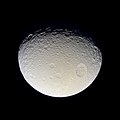Vaizdas:Tethys cassini.jpg

Šios peržiūros dydis: 600 × 600 taškų. Kitos 3 rezoliucijos: 240 × 240 taškų | 480 × 480 taškų | 1 000 × 1 000 taškų.
Didesnės raiškos iliustracija (1 000 × 1 000 taškų, rinkmenos dydis: 368 KiB, MIME tipas: image/jpeg)
Rinkmenos istorija
Paspauskite ant datos/laiko, kad pamatytumėte rinkmeną tokią, kokia ji buvo tuo metu.
| Data/Laikas | Miniatiūra | Matmenys | Naudotojas | Paaiškinimas | |
|---|---|---|---|---|---|
| dabartinis | 21:17, 12 gruodžio 2018 |  | 1 000 × 1 000 (368 KiB) | Kesäperuna | 100% JPEG quality from full quality TIFF. |
| 11:19, 6 gegužės 2015 |  | 1 000 × 1 000 (68 KiB) | Jcpag2012 | Reverted to version as of 05:22, 31 January 2005 | |
| 12:12, 20 kovo 2015 |  | 746 × 680 (60 KiB) | Jcpag2012 | Cropped 25 % horizontally and 32 % vertically using CropTool with lossless mode. | |
| 08:22, 31 sausio 2005 |  | 1 000 × 1 000 (68 KiB) | Bricktop | ||
| 16:31, 29 lapkričio 2004 |  | 600 × 538 (47 KiB) | Wricardoh~commonswiki | Thethys (satellite of Saturn) imaged by the Cassini spacecraft. |
Paveikslėlio naudojimas
Paveikslėlis yra naudojamas šiuose puslapiuose:
Visuotinis rinkmenos naudojimas
Ši rinkmena naudojama šiose viki svetainėse:
- Naudojama af.wikipedia.org
- Naudojama ast.wikipedia.org
- Naudojama be.wikipedia.org
- Naudojama bg.wikipedia.org
- Naudojama bn.wikibooks.org
- Naudojama bs.wikipedia.org
- Naudojama cs.wikipedia.org
- Naudojama da.wikipedia.org
- Naudojama de.wikipedia.org
- Naudojama de.wikibooks.org
- Naudojama el.wikipedia.org
- Naudojama en.wikipedia.org
- Naudojama en.wikibooks.org
- Naudojama en.wikisource.org
- Naudojama eo.wikipedia.org
- Naudojama es.wikipedia.org
- Naudojama fi.wikipedia.org
- Naudojama fr.wikipedia.org
- Naudojama gn.wikipedia.org
- Naudojama hr.wikipedia.org
- Naudojama hy.wikipedia.org
- Naudojama it.wikipedia.org
- Naudojama ja.wikipedia.org
- Naudojama ja.wikibooks.org
- Naudojama ka.wikipedia.org
- Naudojama ko.wikipedia.org
- Naudojama la.wikipedia.org
- Naudojama lv.wikipedia.org
- Naudojama ml.wikipedia.org
- Naudojama ms.wikipedia.org
- Naudojama mwl.wikipedia.org
- Naudojama nl.wikipedia.org
- Naudojama nn.wikipedia.org
- Naudojama no.wikipedia.org
Žiūrėti visuotinį šios rinkmenos naudojimą.



